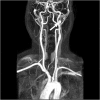Curative effect and mechanism of radiofrequency ablation nucleoplasty in the treatment of cervical vertigo
- PMID: 28257237
- PMCID: PMC5605057
- DOI: 10.1259/bjr.20150772
Curative effect and mechanism of radiofrequency ablation nucleoplasty in the treatment of cervical vertigo
Abstract
Objective: This study aims to investigate the curative effects and mechanism of radiofrequency ablation nucleoplasty in the treatment of cervical vertigo.
Methods: A total of 27 patients diagnosed with cervical vertigo from January 2012 to October 2014 received treatment of radiofrequency ablation nucleoplasty. The narrow-side vertebral artery diameters were examined by using Philips 1.5-T body dual-gradient MRI system. The haemodynamic parameters were detected by using transcranial Doppler sonography. Both of the vertebral artery diameters and haemodynamic parameters were recorded and compared before and after treatment. The curative effects in early post-operative application were evaluated according to the Nagashima standards.
Results: Radiofrequency ablation nucleoplasty was performed in a total of 59 cervical discs in 27 patients. The average operation time was 42.7 min, and the symptoms of 92.6% patients were alleviated after radiofrequency ablation nucleoplasty post-operation application. There was no significant difference in the narrow-side vertebral artery diameters before and after treatment in both Group A (p = 0.12) and Group B (p = 0.48); however, the blood flow velocity was significantly higher than that before treatment in both Group A (p = 0.01) and Group B (p = 0.03), respectively.
Conclusion: Radiofrequency ablation nucleoplasty improves the blood flow in the narrow-side vertebral artery and illustrates the therapeutic effect on cervical vertigo in patients who have no direct compression of the vertebral artery. Advances in knowledge: Radiofrequency intradiscal nucleoplasty can be used as a minimally invasive procedure for treating cervical vertigo.
Figures




Similar articles
-
Therapeutic Effects and Safety of Percutaneous Disc Decompression with Coblation Nucleoplasty in Cervical Vertigo: A Retrospective Outcome Study with 74 Consecutive Patients and Minimum 1-Year Follow-Up.Pain Physician. 2019 May;22(3):E205-E214. Pain Physician. 2019. PMID: 31151343
-
The association between positional vertebral and basilar artery flow lesion and prevalence of vertigo in patients with cervical spondylosis.Otolaryngol Head Neck Surg. 2006 Apr;134(4):680-4. doi: 10.1016/j.otohns.2005.11.023. Otolaryngol Head Neck Surg. 2006. PMID: 16564396
-
Long-Term Clinical Outcomes of Percutaneous Cervical Nucleoplasty for Cervical Degenerative Diseases with Neck Pain and Cervical Vertigo.World Neurosurg. 2020 Jan;133:e205-e210. doi: 10.1016/j.wneu.2019.08.210. Epub 2019 Sep 5. World Neurosurg. 2020. PMID: 31493606
-
[Percutaneous laser disc decompression for cervical vertigo].Zhonghua Wai Ke Za Zhi. 2007 Oct 15;45(20):1408-10. Zhonghua Wai Ke Za Zhi. 2007. PMID: 18241595 Chinese.
-
Pathogenesis, Diagnosis, and Treatment of Cervical Vertigo.Pain Physician. 2015 Jul-Aug;18(4):E583-95. Pain Physician. 2015. PMID: 26218949 Review.
Cited by
-
Moxibustion for cervical vertigo: A protocol for a systematic review and meta-analysis.Medicine (Baltimore). 2020 Jul 31;99(31):e21405. doi: 10.1097/MD.0000000000021405. Medicine (Baltimore). 2020. PMID: 32756137 Free PMC article.
-
The Enduring Controversy of Cervicogenic Vertigo, and Its Place among Positional Vertigo Syndromes.Audiol Res. 2021 Sep 26;11(4):491-507. doi: 10.3390/audiolres11040045. Audiol Res. 2021. PMID: 34698085 Free PMC article. Review.
-
Acupotomy therapy for cervical vertigo: A protocol for a systematic review and meta-analysis.Medicine (Baltimore). 2020 Jul 17;99(29):e20662. doi: 10.1097/MD.0000000000020662. Medicine (Baltimore). 2020. PMID: 32702815 Free PMC article.
-
Patient-Reported Outcome Measures following Coblation Nucleoplasty for Cervical Discogenic Dizziness.J Clin Med. 2023 Jun 30;12(13):4413. doi: 10.3390/jcm12134413. J Clin Med. 2023. PMID: 37445446 Free PMC article.
-
Proprioceptive Cervicogenic Dizziness: A Narrative Review of Pathogenesis, Diagnosis, and Treatment.J Clin Med. 2022 Oct 26;11(21):6293. doi: 10.3390/jcm11216293. J Clin Med. 2022. PMID: 36362521 Free PMC article. Review.
References
-
- Ryan GM, Cope S. Cervical vertigo. Lancet 1955; 31: 1355–8. doi: https://doi.org/10.1016/S0140-6736(55)93159-7 - DOI - PubMed
-
- Takasaki H, Johnston V, Treleaven J, Pereira M, Jull G. Driving with a chronic whiplash-associated disorder: a review of patients' perspectives. Arch Phys Med Rehabil 2011; 92: 106–10. doi: https://doi.org/10.1016/j.apmr.2010.10.008 - DOI - PubMed
-
- Cheng B, Zhang Z, Pei Z. The evaluation of the application effect about resection of tongue cyst by low-temperature plasma radiofrequency ablation system. [In Chinese.] Lin Chung Er Bi Yan Hou Tou Jing Wai Ke Za Zhi 2015; 29: 561–3. - PubMed
-
- Nardi PV, Cabezas D, Cesaroni A. Percutaneouscervical nucleoplasty using coblation technology. Clinical results in fifty consecutive cases. Acta Neurochir Suppl 2005; 92: 73–8. doi: https://doi.org/10.1007/3-211-27458-8_16 - DOI - PubMed
-
- Lee D, Loh E, Kueh C, Poi J, Francis T, Koh K, et al. . Radiofrequency-induced intradiscal nucleoplasty chronic low back pain secondary to lumbar disc herniation. Malays Orthop J 2013; 7: 18–20. doi: https://doi.org/10.5704/MOJ.1307.009 - DOI - PMC - PubMed
MeSH terms
LinkOut - more resources
Full Text Sources
Other Literature Sources
Medical

